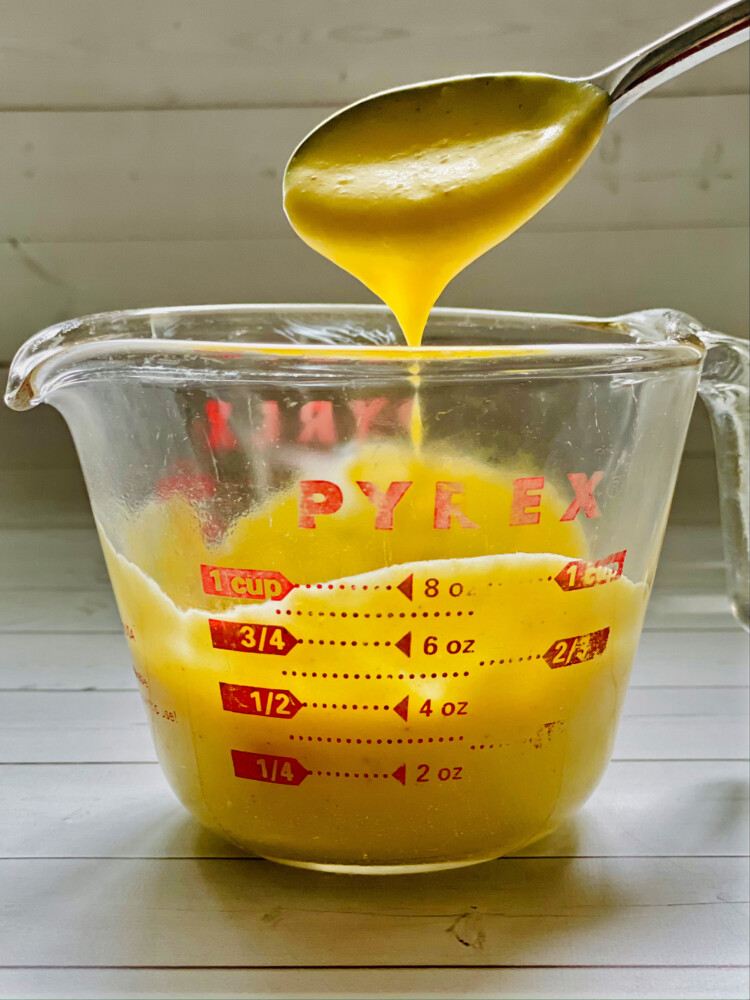Hollandaise and I go way back.
As a teen in western Massachusetts, I cooked Sunday brunch for 150 people weekly from a tiny kitchen at the back of a renovated 1880s train station. Eggs Benedict with Hollandaise – one of the five classic French mother sauces, made by whipping clarified butter into egg yolks until the mixture emulsifies – was a big seller. The Hollandaise sauce we served derived from a powdery product sold by restaurant goods wholesaler Sysco Foods into which I stirred in melted butter. It was a very stable sauce that sat in a large double boiler set atop the flattop grill. As an end-of-service cook’s treat, I’d ladle leftovers over extra-crispy home fries. I was in love.
The luster wore off my young love when I made it badly, from scratch, in culinary school 25 years later. “Rudalevige!!” scowled the chef instructor rendering my mother sauce practicum. “I’m not even going to taste that yellow Play-doh!” My yield was less than half of what it was supposed to be, signaling that I added too much butter to the sauce.
The chef instructor proctoring my vegetable cookery test was similarly nonplussed by the broken Sauce Maltaise – a Hollandaise derivative that adds blood orange zest and juice – lying under my plated white asparagus. When a sauce splits, the fat has separated from the egg foam. A sauce that has lost its emulsion (likely the fault of the cook adding the butter too quickly, thereby scrambling the egg yolks) looks thin, greasy and lumpy.
I broke up with Hollandaise at that point. But we reconnected last week when I had farm fresh eggs and a bit of heavy cream in the house and I was reading a post on the popular cooking website The Kitchn about a foolproof method for making Hollandaise. The recipe was originally published in “Desperation Dinners,” a cookbook by Beverly Mills and Alicia Ross. Purists will call this pseudo-Hollandaise because it incorporates heavy cream – it’s the stabilizer – and the Hollandaise is cooked in the microwave.
The formula is simple: 4 tablespoon melted butter, 2 egg yolks, juice from half a lemon, 1/4 cup heavy cream, 1/2 teaspoon Dijon mustard and a pinch each of salt and cayenne pepper. You combine the butter, yolks, lemon juice and heavy cream in a large microwave-safe glass measuring cup. Then you microwave in 15-second bursts, whisking between each blast, until the mixture is slightly thickened but still pourable. It takes a minute to a minute and a half to reach about 185 degrees, the temperature at which the eggs will thicken the sauce and are safe to consume. Stir in the mustard. Season with salt and cayenne to taste.
I’m not a purist, just someone who doesn’t want to waste the fresh eggs and dairy products from Maine farmers that make their way into my kitchen. Even better, leftovers can be stored in the fridge for a couple of days and reheated for 15 seconds without breaking up.
Christine Burns Rudalevige is a food writer, recipe developer, tester and cooking teacher in Brunswick, and the author of “Green Plate Special,” a cookbook from Islandport Press based on these columns. She can be contacted at: cburns1227@gmail.com.

Waste-Not Scrambled Eggs on Toast with Hollandaise, and shishito peppers on the side. Photo by Christine Burns Rudalevige
Waste-Not Scrambled Eggs on Toast with Hollandaise
The photo shows eggs scrambled with the last of the red onion in the fridge and the cherry tomatoes on the counter on toasted day-old country bread from Standard Bakery. Grilled shishito peppers are great on the side because they get along very well with Hollandaise.
Serves 2 with leftover Hollandaise
FOR THE SAUCE
4 tablespoons melted butter
2 egg yolks (reserve the whites for the Eggs on Toast)
Juice from half a lemon
1/4 cup heavy cream
1/2 teaspoon Dijon mustard
Salt and cayenne pepper
FOR EGGS ON TOAST
4 slices bacon
1/4 cup minced red onion
1/2 cup chopped tomatoes
3 whole eggs and 2 reserved whites beaten with 1/4 teaspoon each kosher salt and black pepper
2 slices day-old bread, toasted
Chopped chives, for garnish
To make the sauce, combine the butter, yolks, lemon juice and heavy cream in a large microwave-safe glass measuring cup. Microwave the mixture in 15-second bursts, whisking between each blast, until slightly thickened, but still pourable, about 1 to 1½ minutes total. Stir in the mustard. Season with salt and cayenne to taste. Set aside.
To make eggs on toast, place the bacon in a nonstick skillet and cook over medium heat to your preferred doneness. Transfer the cooked bacon to a recycled paper bag to drain. Pour off all but 1 tablespoon of bacon grease. Return the pan to medium heat. Add the onions and cook for 2 minutes. Add the tomatoes and cook for 2 minutes more. Pour in the beaten eggs and cook to preferred doneness.
Warm the Hollandaise in the microwave for 15 seconds, if needed.
Place toast on plates. Top with bacon, scrambled eggs and Hollandaise. Garnish with chopped chives and serve immediately.
Send questions/comments to the editors.



Comments are no longer available on this story